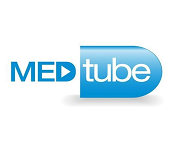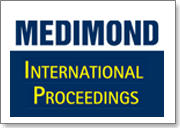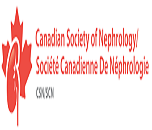Theme: Integrating recent discoveries and interpreting clinical research for better renal health
Nephrology-2015
OMICS International is proud to announce the initiation of “4th International Conference on Nephrology and Therapeutics” which is scheduled to organize on September 14-16, 2015 at Baltimore, USA. The scientific program concentrates around the theme “Integrating recent discoveries and interpreting clinical research for better renal health.” The 4th International Conference on Nephrology & Therapeutics will discuss the latest technologies and therapeutic aspects developed for various kidney diseases which include renal transplantation, dialysis equipments and other procedures involved in treatment of Chronic Kidney Diseases and End Stage Renal Diseases. The Organizing committee of Nephrology conference takes the honour of inviting Renowned nephrologists, renal transplantation surgeons, immunologists, diabeticians, physicians, World-class surgeons, Young researchers, Business delegates and talented student communities working in the field of nephrology to share their research experiences and indulge in interactive discussions at the event.
OMICS International Organises 300+ International Conferences every year across USA, Europe & Asia with support from 1000 more scientific societies and Publishes 400+ Open access journals which contains over 30000
According to recent statistics report, nearly 26 million adults apart from young and old aged people are suffering from Chronic Kidney Disease complaints and millions of others are at increased risk. The numbers of Kidney transplantations are seemingly very high and in the year of 2013 alone, there are around 15000 kidney transplantations. Being one of the major fields of Internal Medicine, Nephrological research received a funding of more than 5 billion dollars annually across the globe. Nearly $560 million is being funded on Kidney diseases alone per year. Due to the rapid increase for the risk of renal disorders, OMICS Group aims to decrease the incidence rate of kidney disease through its international conference on nephrology and cordially invites participants across the globe to discuss and arrive under possible solutions for one of the major critical problems of mankind.
Scientific Sessions
Track-1 Renal Dialysis and Procedures
Renal dialysis (process the blood when the kidneys have failed) will require access to the blood stream. This procedure involves either insertion of a catheter and/or creation of a transmission between an artery and a vein beneath the skin. Usually this is accomplished in the patient’s arm and is often accomplished as an outpatient procedure. Dialysis treatments replace some of these functions through diffusion there are two main types of dialysis: haemodialysis and peritoneal dialysis. Haemodialysis and peritoneal dialysis are both used to treat kidney failure. Haemodialysis uses a man-made membrane (dialyzer) to filter wastes and remove extra fluid from the blood. Peritoneal dialysis uses the lining of the abdominal cavity (peritoneal membrane) and a solution (dialysate) to remove wastes and extra fluid from the body. Both haemodialysis and peritoneal dialysis can cause side effects. During this 5 year study the investigators would like to test if a different nutrition and diet can explain better survival of minority dialysis patients. The investigators will also test if in additional to nutrition there are 2 other reasons for better survival of minority dialysis patients, namely differences in bone and minerals and differences in social and psychological and mental health. The investigators plan to study 450 haemodialysis patients every 6 months in several dialysis clinics in Los Angeles South Bay area. These subjects will include 30% African Americans, 30% Hispanics, 30% non-Hispanic Whites and 10% Asians. In the HEMO study, the incidence of infection-related deaths was not reduced by higher dose of dialysis or by high-flux dialyzers, and most infection-related hospitalizations were not attributed to vascular access.
Nephrology-2015 Targets, CEO’s , Directors, Scientists, Professors, Students, Diabeticians, Directors & Brand Manufacturers/ Marketers of Consumer Products globally. Nephrology associated Universities are 55 nearly in USA and Major Nephrology Societies are 17 around the globe. Large scale research development is being conducted in the field of nephrology for the past two decades. Tripled in value from USD 560 million is being funded on Kidney diseases alone per year. Baltimore (Maryland) also bears a total 3,500 hospitals working on Nephrology & Therapeutics. Hence it’s considered to be one of the finest places for a Conference on Nephrology.
Track-2 Renal Transplantation and Immunology
Transplantation is the act of transferring cells, tissues, or organs from one site to another. The malfunction of an organ system can be corrected with transplantation of an organ example: kidney from a donor. Since the first successful Renal transplantation (RT) performed between the identical twins in the Peter Brent Brigham Hospital, Boston on 23rd December 1954 by Murray et al., RT has become a routine for the patients with end-stage renal disease. When a kidney is transplanted from a Non-identical individual, the allograft; the recipient mounts a Immuneresponse termed as an immune response. The immune response is initiated by the T cell recognition of the alloantigen and process is commonly known as the allorecognition. The first step of the complex events that leads to T lymphocyte activation, antibody production, allograft rejection and Transplant failure. This review highlights the fundamental principles of Transplant immunology and modern immunological assay techniques, which have important application in practice.
Understanding of the immunology related advances in the techniques of detection and characterisation of antibodies before and after renal transplantation and the cross match techniques have significantly improved the outcomes of renal transplantation over last two decades. Approval was based on two randomized studies involving 1,093 patients with organ rejection in kidney transplant recipients. Currently, 1-year graft survival rates after renal transplantation are exceeding 90%. However, the life-long administration of Immunosuppressive drugs is accompanied by many side effects. These renal failure events findings may contribute to the development of in vitro monitoring tools to identify transplant patients in whom immunosuppressant can be safely reduced in order to avoid long term side effects.
Track-3 Chronic and End Stage Renal diseases
Renal failure refers to temporary or permanent damage to the kidneys those results in loss of normal kidney function. There are two different types of Renal failures-acute and chronic. Acute renal failure has an abrupt onset and is potentially reversible. Chronic renal failure progresses slowly over at least three months and can lead to permanent renal failure. The causes, symptoms, treatments, and outcomes of acute and chronic are different. Chronic kidney disease, as defined since 2002 by the presence of kidney damage or reduced Glomerular filtration rate (GFR), affects 10% of the adult population worldwide and more than one-third of the elderly. A recent large Meta analysis of 46 general population, high risk and CKD, including more than 2 million participants, showed that both low estimated GFR and high albuminuria were associated with increased risk of all-cause mortality, cardiovascular disease and progression to End-stage renal disease (ESRD) regardless of age.
The small geographic variation in CKD prevalence and the large variation in ESRD incidence, three times higher, for example, in the USA than in Europe. Finally, quality of life and patient rating of healthcare remain under studied in early-stage CKD despite increasing recognition of the importance of patient-reported outcomes in clinical trials and public health. Thus, chronic kidney disease conferences was identification of new predictive markers is also necessary to improve risk assessment in CKD. Several biomarkers emerging from epidemiological studies are promising, but further evidence is needed before they can be routinely used to predict outcomes.
Track-4 Renal Transplantation and Immunology
Transplantation is the act of transferring cells, tissues, or organs from one site to another. The malfunction of an organ system can be corrected with transplantation of an organ example: kidney from a donor. Since the first successful Renal transplantation (RT) performed between the identical twins in the Peter Brent Brigham Hospital, Boston on 23rd December 1954 by Murray et al., RT has become a routine for the patients with End-stage renal disease. When a kidney is transplanted from a Non-identical individual, the allograft; the recipient mounts a Immuneresponse termed as an immune response. The immune response is initiated by the T cell recognition of the alloantigen and process is commonly known as the allorecognition. The first step of the complex events that leads to T lymphocyte activation, antibody production, allograft rejection and Transplant failure. This review of kidney transplantation events highlights the fundamental principles of Transplant immunology and modern immunological assay techniques, which have important application in practice. Understanding of the immunology related advances in the techniques of detection and characterisation of antibodies before and after renal transplantation and the cross match techniques have significantly improved the outcomes of renal transplantation over last two decades.
Approval was based on two randomized studies involving 1,093 patients with organ rejection in kidney transplant recipients. Currently, 1-year graft survival rates after renal transplantation are exceeding 90%. However, the life-long administration of Immunosuppressive drugs is accompanied by many side effects. These renal diagnosis conferences findings may contribute to the development of in vitro monitoring tools to identify transplant patients in whom immunosuppressant can be safely reduced in order to avoid long term side effects.
Track-5 Nephritis, Onconephrology and Diabetic Nephropathy
Diabetic's nephropathy Diabetic nephropathy also known as Kimmelstiel–Wilson syndrome, or nodular diabetic glomerulosclerosisand intercapillary glomerulonephritis, is a progressive kidney disease caused by angiopathy of capillaries in the kidney glomeruli. It is characterized by nephrotic syndrome and diffuse glomerulosclerosis. It is due to longstanding diabetes mellitus, and is a prime indication for dialysis in many developed countries. It is classified as a small blood vessel complication of diabetes. Clinically, diabetic nephropathy is characterized by a progressive increase in proteinuria and decline in GFR,Hypertension, and a high risk of cardiovascular morbidity and mortality. Diabetes has become the primary cause of End-stage renal disease (ESRD) in the United States, and the incidence of type 2 diabetes mellitus continues to grow in the United States and worldwide as described in Nephritis conferences.
Approximately 44% of new patients entering dialysis in the United States are diabetics. Early diagnosis of diabetes and early intervention are critical in preventing the normal progression to renal failure seen in many type 1 and a significant percentage of type 2 diabetics. Approximately 20.8 million people, or 7.0% of the population in the United States, are estimated to have diabetes, with a growing incidence. Roughly one third of this population, 6.2 million, is estimated to be undiagnosed with type 2 diabetes. The prevalence of diabetes is higher in certain racial and ethnic groups, affecting approximately 13% of African Americans, 9.5% of Hispanics, and 15% of Native Americans, primarily with type 2 diabetes.1, 2 approximately 20% to 30% of all diabetics will develop evidence of nephropathy, although a higher percentage of type 1 patients progress to ESRD.
Track-6 Metabolic, Fluid and Electrolyte Disorders
Electrolytes play a vital role in maintaining homeostasis within the body. Some minerals—especially the macro minerals (minerals the body needs in relatively large amounts)—are important as electrolytes. The kidneys help maintain electrolyte concentrations by filtering electrolytes from blood, returning some electrolytes to the blood, and excreting any excess into the urine. Thus, the kidneys help maintain a balance between daily consumption and excretion. The physician should first explore all treatable causes of renal failure, example: Dehydration, Obstruction, Infection, Heart failure, Potassium depletion, and others. Approximately 90 percent of cases of end-stage renal disease are attributable to diabetes mellitus, glomerulonephritis, or hypertension. Kidney failure results in Fluid and Electrolyte imbalances, the build up of nitrogenous wastes, and reduced ability to produce renal hormones. The two treatment options are transplantation or dialysis. Kidney stones can also form from uric acid, which is a breakdown product of protein, or from struvite (ammoniomagnesium phosphate) or cystine.
The prevalence of kidney stones is three times higher in men than women, and is higher among Caucasians than Asians or African Americans, for reasons that are not clear. They are especially likely to strike between the ages of 40 and 60.Encourage patients to avoid animal products. Their proteins and sodium content increase the risk of stones.
Track-7 Experimental Nephrology and Renal Anaemia
In general, patients with Anemia of chronic illness or chronic kidney disease can be treated on an outpatient basis. Confounding factors that need to be addressed in both diseases include concomitant blood loss, iron deficiency, or deficiencies of vitamin B12 and/or folic acid. When kidneys start to fail, little or no Erythropoietin (EPO) is produced and this results in a failure of red cell production. Another factor causing anaemia in kidney disease can be iron deficiency as iron is not absorbed so the kidneys start to fail this leads to Renal anaemia. Several million patients with chronic kidney disease (CKD) have benefited from the use of erythropoiesis-stimulating agents (ESAs) to correct severe anemia. Sometimes Haematopoies the formation of blood cellular components. All cellular blood components are derived from haematopoietic stem cells and Kidney biopsy is a medical procedure in which a small piece of kidney is removed from the body for examination, usually under a microscope. Microscopic examination of the tissue can provide information needed to diagnose, monitor or treat problems of the kidney. However, mortality data now suggest that treating CKD patients to achieve a haemoglobin (Hb) level >13 g/dl can be harmful.
In 2004, the report of the Dialysis Outcomes and Practice Patterns Study, which used data from >11,000 patients in 12 countries, showed an association with a significantly higher mortality when patients with an Hb level low were compared with those with higher levels this finding was reflected in the European experience.
Track-8 Treatment and Surgery for Renal diseases
Surgery is the main treatment for most kidney cancers. The chances of surviving kidney cancer without having surgery are small. Depending on the stage and location of the cancer and other factors, surgery may remove either the cancer along with some of the surrounding kidney tissue (known as a partial nephrectomy), or the entire kidney (known as a radical nephrectomy). The adrenal gland (the small gland that sits on top of each kidney) and fatty tissue around the kidney may be removed as well. Regenerative medicine refers to a group of biomedical approaches to clinical therapies that may involve the use of stem cells. The study of laparoscopy in managing patients with abdominal symptoms from autosomal dominant Polycystic kidney disease (PKD).
From April 1993 to July 1995, four patients with ADPKD underwent seven laparoscopic procedures: five cyst decortications were performed in two patients using a laparoscopic ultrasound unit and two laparoscopic nephrectomies were performed in two patients with end-stage renal failure. The mean operative time was 207 minutes for laparoscopic cyst decortication and 272 minutes for laparoscopic nephrectomy. Many people feel that a successful kidney transplant provides a better quality of life because it may mean greater freedom, more energy and a less strict diet.
Track-9 Diagnostic, Imaging and Radiation techniques
Medical imaging is the technique and process of creating visual representations of the interior of a body for clinical analysis and medical intervention. Medical imaging seeks to reveal internal structures hidden by the skin and bones, as well as to diagnose and treat disease. Renal Scintigraphy, also known as "Renal scanning" or "Renal imaging," refers to several examinations using radioisotopes that evaluate the function and anatomy of the kidneys. Renal Scintigraphy is one of many imaging methods used to evaluate the kidneys. Ultrasound, Computed Tomography (CT), and Magnetic Resonance Imaging (MRI) can also be used. Your doctor will determine which of these examinations will provide the best information about your kidneys. Because the radiotracer accumulates differently in different kinds of tissue, it can help physicians determine if something is wrong with the kidneys. Renal Scintigraphy can also be used to evaluate a transplanted kidney.
The medical image analysis market is driven by the increasing demand of the imaging modalities across various indications such as Oncology, Cardiology and Nephrology. The medical image analysis market is estimated to be $1.7 billion in 2012 and is growing at a rate of 7.2% from 2012 to 2017 to reach $2.4 billion. The Americas have the largest share in the open MRI market on account of the increasing aging populations who are aware of the benefits of early diagnosis.
Track-10: Clinical Nephrology
Now, a day’s new Clinical Nephrology developments in kidney failure treatment have helped many patients. Since no specific in alternative and Ayurvedic medicine for kidney can help treat kidney failure effectively, the best method is to combine them. Immunotherapy, as one great breakthrough in treating end-stage kidney disease, is just a combination of advanced western medical technologies and traditional herbal medicines, so this therapy mainly has two big effects. One is to purify patient’s blood, just as dialysis does. A clear internal environment can have a good preparation for the following treatment. The other effect of Immunotherapy is to repair damaged kidney cells which is due to poor blood and oxygen supply. To alter this situation, some herbal medicines such as rheum officinal and astragals mongholicus are used to increase the blood flow on the kidney to transport enough nutrition to the damaged cells. After a period of treatment, these kidney cells can recover to work again, so patients’ kidney function and life quality can be improved largely.
Once patient’s kidney function is increased to more than 15%, it is possible for these patients to avoid dialysis or further dialysis. There is no evidence to prove that stem cell can cure kidney disease. But, the medical effectiveness of stem cells treatment is now viable and worthwhile. Stem cells treatment can make the kidneys functioning as much as possible for as long as possible, with little hope of recovery; medical advances have proved that stem cells have a remarkable power to increase the function of the kidneys as reviewed in kidney stones conferences.
During our Nephrology meeting of three day event, which aims to incorporate real-time imaging into the diagnostic and treatment strategy for prostate and kidney diseases, delegates will have the opportunity to get valuable insights by attending to an exciting and interactive scientific program with state of the art presentation, video demonstrations and hands- on workshops, delivered by a World-class faculty. Participants will also have the opportunity to networking with our faculty and exchange opinions and experiences.
The “4th International Conference on Nephrology & Therapeutics” will be hosted at Baltimore, Maryland, USA during September 14-16, 2015, with the innovative theme “Integrating recent discoveries and interpreting clinical research for better renal health.”Nephrology-2015 is the leading event which rotates between continents and is organized in collaboration with regional nephrology societies.
Summary of Nephrology & Therapeutics Conference:
Nephrology deals with study of kidneys as well as its diseases like normal kidney function, kidney problems, the treatment of kidney stone problems and renal replacement therapy, CKD which are common like haemodialysis and kidney transplantation. Kidney function studies: Increased levels of blood urea nitrogen and creatinine are the hallmarks of acute renal failure. Systemic conditions that affect the kidneys such as diabetes and autoimmune disease and systemic problems that occur as a result of kidney problems such as renal osteodystrophy and hypertension are also studied in nephrology. A physician who has undertaken additional training to become an expert in nephrology may call themselves a nephrologists or renal physician.
Nephrology-2015 congress is an international platform for presenting research about latest techniques, newer technologies and various newly implemented drugs for the treatment of kidney diseases, exchanging ideas about it and thus, contributes to the dissemination of knowledge and decreases the incidence rate globally. This event brings together senior brand marketers and agency executives to explore latest equipments and technologies developed renal diagnosis, and treatment for renal dialysis. Nephrology-2015 is where marketers go to gain perspective on the latest platforms, emerging start-ups, and opportunities that will drive the future of the technologies. We bring together Academia, Researchers, Student community and Business.
According to recent statistics report, nearly 26 million adults apart from young and old aged people are suffering from Chronic Kidney Disease complaints and millions of others are at increased risk. The numbers of Kidney transplantations are seemingly very high and in the year of 2013 alone, there are around 15000 kidney transplantations. Due to the rapid increase for the risk of renal disorders, Nephrology-2015 aims to decrease the incidence rate of kidney disease through its international conference on nephrology and cordially invites participants across the globe to discuss and arrive under possible solutions for one of the major critical problems of mankind.
Scope and Importance of Nephrology & Therapeutics Research:
Nephrology-2015 conference has been fostering the need to control the impact of permanent renal disease within the public health environment. The lack of a systematized control provided through a measurable program has greatly impacted on the level of hospital expense since they have increased their case-mix risk, family economies deteriorate and health care pays for a higher morbimortality that could be avoided with better surveillance and epidemiological control. Nephrology-2015 aims to bring together leading Researchers, Academicians, Physicians and Industrialists to exchange and share their experiences and research in order to decrease the incidence rate of kidney disease by new techniques and latest technologies.
This unique opportunity to hear the latest discoveries and network with global experts to discuss improving patient care, Renal Data System trends, and key findings at an open forum for providers to share best practices discussions about reducing hospitalizations, improving volume control, increasing the PD patient population, nutritional management and sodium modelling, and CKD education. The Organizing committee of Nephrology conference takes the honour of inviting Renowned nephrologists, renal transplantation surgeons, immunologists, Diabeticians, physicians, World-class surgeons, Young researchers, Business delegates and talented student communities working in the field of nephrology to share their research experiences and indulge in interactive discussions at the event.
Why it’s in Baltimore, USA:
Baltimore is divided officially into nine geographical regions: Northern, North-western, Northeastern, Western, Central, Eastern, Southern, South-western, and South-eastern, with each patrolled by a respective Baltimore Police Department district. However, it is common for locals to divide the city simply by East or West Baltimore, using Charles Street as a dividing line, and/or into North and South using Baltimore Street as a dividing line. Baltimore is the largest independent city in the United States and the largest city and cultural center of the U.S. state of Maryland. The city is located in central Maryland along the tidal portion of the Patapsco River, an arm of the Chesapeake Bay. Baltimore is sometimes referred to as Baltimore City in order to distinguish it from surrounding Baltimore County. Founded in 1729, Baltimore is a major U.S seaport and is situated closer to major Midwestern markets than any other major seaport on the East Coast. Baltimore’s Inner Harbor was once the second leading port of entry for immigrants to the United States and a major manufacturing center.
Four universities in Baltimore rank among the world’s best, in the 2013/14 QS World University Rankings. Three of these are public universities; University of Maryland, Towson State University, Morgan State University and the Johns Hopkins University and Johns Hopkins Hospital are now the city’s largest employers. All of these the top universities in Florida are comprehensive institutions, offering courses in a wide range of subject areas.
Members Associated with Nephrology & Therapeutics Research:
There are 10,0000 professional members from more than 126 countries. In addition, with eminent scientists from across 120 countries, Directors & CEO’s, Researchers, Post Docs, Physicians including transplant surgeons, Immunologists, Diabeticians, Directors & Brand Manufacturers/ Marketers of Consumer Products. Professors and Students from academia in the field of Nephrology.
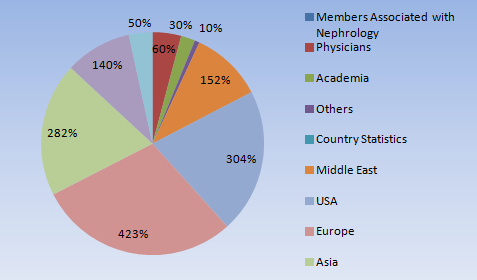
Hospitals Associated with Nephrology & Therapeutics Research:
There are several hospitals offering kidney treatments including dialysis and transplantation. They are well known for health care and fast recovery is promised from the hospital combined with a pleasant and suitable caring atmosphere. According to the global statistics they were nearly 12000 Hospitals in cites associated with kidney treatments and 17790 doctors of USA working in the hospitals.
Hospitals Associated with Nephrology in USA
Johns Hopkins Hospital
Saint Agnes Hospital
Bon Secours Hospital
Baltimore VA Medical Center
St. Agnes Hospital
Maryland Medical Center
Sinai Hospital of Baltimore
Northwest Hospital
Mercy Medical Center
Kennedy Krieger Institute

Societies Associated with Nephrology & Therapeutics Research:
Nephrology Societies leads the fight against kidney disease by educating health professionals, sharing new knowledge, advancing research, and advocating the highest quality care for patients. As per the statistics they were 9,000 Nephrology societies across the globe.ica
Major Nephrology Societies around the Globe:
International Society of Nephrology (ISN)
American Society of Nephrology (ASN)
Indian Society of Nephrology (ISN)
Canadian Society of Nephrology (CSN)
Hong Kong Society of Nephrology (HKSN)
The Renal Association
Australian and New Zealand Society of Nephrology (ANZSN)
Malaysian Society of Nephrology (MSN)
National Kidney Foundation (NKF)
Saudi Society of Nephrology and Transplantation (SSN&T)
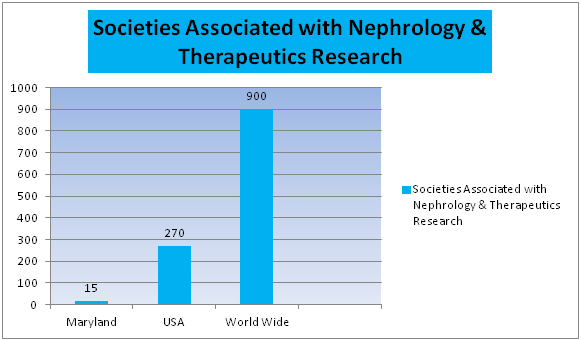
Industries Associated with Nephrology & Therapeutics Research:
Profiles of 1600 leading Industries out of 35production and functional industries were involved with each component of this diagnostic system is designed and developed with utmost engineering using most advanced technology considering the requirements of clinicians engaged in interventional procedures.
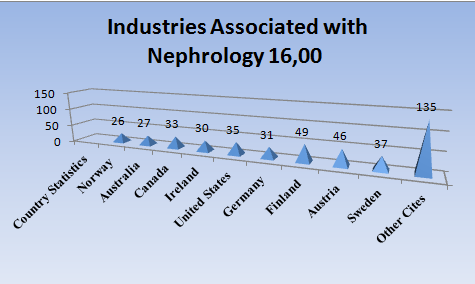
Universities Associated with Nephrology & Therapeutics Research:
Top Universities of Nephrology in USA:
Albany Medical College
Boston University School of Medicine
Columbia University College of Physicians and Surgeons
David Geffen School of Medicine at UCLA
Florida State University College of Medicine
Georgetown University School of Medicine
Indiana University School of Medicine
Johns Hopkins University School of Medicine
Loma Linda University School of Medicine
Northeastern Ohio Universities College of Medicine
Ohio State University College of Medicine
Tulane University School of Medicine
University of Maryland
Vanderbilt University School of Medicine
Weill Cornell Medical College
Yale University School of Medicine

Market Value on Nephrology & Therapeutics Research:
The global nephrology market will grow from nearly $3.8 billion in 2012 to $4 billion in 2013. In 2014 to be worth $6.3 billion for a compound annual growth rate (CAGR) of 2.7%.This year, the global market for products used in the fight against kidney diseases will be worth an estimated $5.5 billion, according to a new technical market research report, the Global Nephrology Market, from USA Research. Market revenue is forecast to increase at a five-year compound annual growth rate (CAGR) of 8% from 2013 to 2018, totalling nearly $6 billion in 2018, and it is estimated that on an average 25% of the population throughout the world will be effected with Kidney Diseases by 2025.
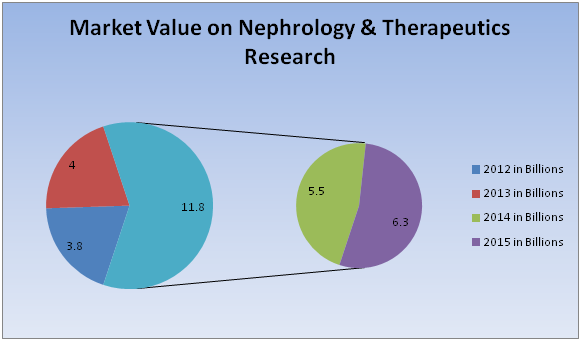
Market Growth of Nephrology & Therapeutics Research in the last and upcoming ten years:
The growth in the number of training programs and slots has likely been driven by a variety of factors, including a perceived workforce shortage, efforts by both academic and private practice nephrologists to enhance their own workforce to meet clinical demands, and the laudable desire to develop and maintain teaching programs by both academic and practicing nephrologists. This increase in training slots has led to a dramatic increase in nephrologists. Between 2015 and 2020, nephrology grew more rapidly than any internal medicine subspecialty other than geriatrics. The increasing number of graduating trainees and practicing nephrologists may in the near future, if it has not already, lead to a sluggish job market for new trainees.
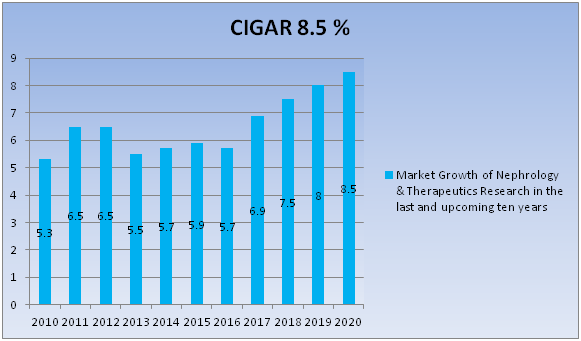
Products manufactured by the industry related Nephrology & Therapeutics Research and it’s Market Value:
• MIRACA Holdings Inc. - Provides medical, surgical care centres, USA
• Intuitive Surgical Inc. – Kidney care services, USA
• Sonova Holdings - provides practice management services for active Nephrologists, USA
• Ship Healthcare Holdings Inc. - Diabetic nephropathy, USA
• Edwards Lifesciences - Management services to transplantation practices, USA
• Smith & Nephew plc - Ayurvedic medicine for kidney, USA
• Baxter International Inc.- Kidney cancer care center, USA
Fund Allotment to Nephrology & Therapeutics Research:
Being one of the major fields of Internal Medicine, Nephrological research received a funding of more than 5 billion dollars annually across the globe. Nearly $560 million is being funded on Kidney diseases alone per year. The maximum level of funding is $80,000 per year in USA and shall be used principally to support the global development as well as training-related expenses.
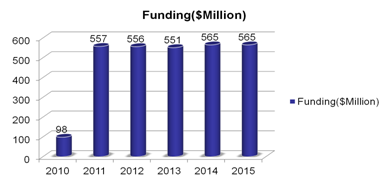
Statistics of Marketers, Researchers and Academicians working on Nephrology:
Nephrology-2015 conference gathers renowned scientists, physicians, surgeons, young researchers, industrial delegates and talented student communities in the field of nephrology under a single roof where networking and global partnering happens for the acceleration of future research. Following are the areas for targeting the audience from Maryland, USA :
Physicians 900
Student 1500
Academia 220
Therapist’s 1200

Conference Highlights
- Renal Dialysis and Procedures
- Renal Genetic syndromes
- Chronic and End Stage Renal Diseases
- Renal Transplantation and Immunology
- Nephritis, Onconephrology and Diabetic Nephropathy
- Metabolic, Fluid and Electrolyte Disorders
- Experimental Nephrology and Renal Anaemia
- Treatment and Surgery for Renal diseases
- Diagnostic, Imaging and Radiation techniques
- Clinical Nephrology
To share your views and research, please click here to register for the Conference.
To Collaborate Scientific Professionals around the World
| Conference Date | September 14-16, 2015 | ||
| Sponsors & Exhibitors |
|
||
| Speaker Opportunity Closed | Day 1 | Day 2 | Day 3 |
| Poster Opportunity Closed | Click Here to View | ||
Useful Links
Special Issues
All accepted abstracts will be published in respective Our International Journals.
- Journal of Nephrology & Therapeutics
- Journal of Diabetes & Metabolism
- Internal Medicine: Open Access
Abstracts will be provided with Digital Object Identifier by












